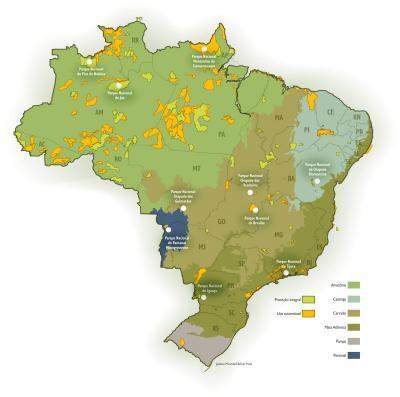Reservas florestais são importantes para reduzir os impactos das queimadas na Amazônia

[Por Henrique Cortez, do EcoDebate] As reservas florestais (UC, Flona’s, etc), sempre sob severa crítica do expansionismo agropecuário, mostram ser importantes para reduzir a devastação das queimadas. Esta é a conclusão de um estudo [Reserves Protect against Deforestation Fires in the Amazon] publicado na edição de 8/4 da revista online PLoS ONE.
Pesquisadores da Duke University demonstraram a importância das reservas florestais, mesmo quando atravessadas por estradas, ao funcionarem como barreiras ao avanço dos incêndios florestais.
As queimadas ilegais são um destacado método de devastação na Amazônia. As florestas úmidas não possuem proteção natural ao fogo, ao contrário de outras florestas que conseguem se recompor e até expandir depois do incêndio.
Os pesquisadores estimam que 90% das queimadas acorrem em até 10 km das rodovias, que devem ser consideradas como fator chave do desflorestamento e das queimadas.
As reservas possuem alta densidade vegetal, o que reduz a expansão das queimadas, reduzindo a sua velocidade e área de impacto.
Determinar se as reservas com estradas proporcionam proteção contra a devastação causada pelos incêndios florestais é um fator crítico, porque o ritmo de construção de estradas se acelerou, nos últimos anos, em muitas partes da Amazônia brasileira, incluindo em muitas reservas.
Especialmente importantes são as reservas indígenas da região, que abrangem cinco vezes a área de parques e reservas protegidas. Apesar de estradas e assentamentos em muitas destas reservas indígenas elas são importantes para o equilíbrio ecológico das áreas de floresta tropical afetadas pelo desenvolvimento em áreas circunvizinhas.
Para avaliar o grau de proteção que as reservas com estradas podem fornecer contra estes incêndios, os pesquisadores analisaram dez anos de imagens de satélite das queimadas em toda a Amazônia brasileira.
Em geral, eles não encontraram nenhuma diferença significativa na incidência entre fogo de uso sustentável de reservas, reservas indígenas e parques protegidos.
Incêndios florestais são mais prováveis de ocorrer durante os anos com a ocorrência do El Nino, tendo em vista que, nestes anos, a floresta está mais seca e, portanto, mais vulnerável ao fogo.
Mas, o aumento de incêndios nas ocorrências do El Niño anos foi mais significativo fora da área das reservas, o que indica que elas também atuam como proteção para estes efeitos climáticos.
Os resultados mostram que mesmo as reservas habitadas podem ser um instrumento eficaz para reduzir os incêndios, ainda que sejam atravessadas por estradas.
O artigo “Reserves Protect against Deforestation Fires in the Amazon” publicado na revista online PLoS ONE está disponível para acesso integral no formato HTML. Para acessar o artigo clique aqui.
Para maiores informações transcrevemos, abaixo, o abstract:
Reserves Protect against Deforestation Fires in the Amazon
J. Marion Adeney, Norman L. Christensen, Jr, Stuart L. Pimm*
Nicholas School of the Environment, Duke University, Durham, North Carolina, United States of America
Background
Reserves are the principal means to conserve forests and biodiversity, but the question of whether reserves work is still debated. In the Amazon, fires are closely linked to deforestation, and thus can be used as a proxy for reserve effectiveness in protecting forest cover. We ask whether reserves in the Brazilian Amazon provide effective protection against deforestation and consequently fires, whether that protection is because of their location or their legal status, and whether some reserve types are more effective than others.
Methodology/Principal Findings
Previous work has shown that most Amazonian fires occur close to roads and are more frequent in El Niño years. We quantified these relationships for reserves and unprotected areas by examining satellite-detected hot pixels regressed against road distance across the entire Brazilian Amazon and for a decade with 2 El Niño-related droughts. Deforestation fires, as measured by hot pixels, declined exponentially with increasing distance from roads in all areas. Fewer deforestation fires occurred within protected areas than outside and the difference between protected and unprotected areas was greatest near roads. Thus, reserves were especially effective at preventing these fires where they are known to be most likely to burn; but they did not provide absolute protection. Even within reserves, at a given distance from roads, there were more deforestation fires in regions with high human impact than in those with low impact. The effect of El Niño on deforestation fires was greatest outside of reserves and near roads. Indigenous reserves, limited-use reserves, and fully protected reserves all had fewer fires than outside areas and did not appear to differ in their effectiveness.
Conclusions/Significance
Taking time, regional factors, and climate into account, our results show that reserves are an effective tool for curbing destructive burning in the Amazon.
Citation: Adeney JM, Christensen NL Jr, Pimm SL (2009) Reserves Protect against Deforestation Fires in the Amazon. PLoS ONE 4(4): e5014. doi:10.1371/journal.pone.0005014
Editor: Rob P. Freckleton, University of Sheffield, United Kingdom
Received: September 3, 2008; Accepted: February 28, 2009; Published: April 8, 2009
Copyright: © 2009 Adeney et al. This is an open-access article distributed under the terms of the Creative Commons Attribution License, which permits unrestricted use, distribution, and reproduction in any medium, provided the original author and source are credited.
Funding: A NASA Earth System Science Fellowship supported JMA. The funders had no role in study design, data collection and analysis, decision to publish, or preparation of the manuscript.
Competing interests: The authors have declared that no competing interests exist.
* E-mail: stuartpimm{at}aol.com
[t]
[EcoDebate, 13/04/2009]
Inclusão na lista de distribuição do Boletim Diário do Portal EcoDebate
Caso queira ser incluído(a) na lista de distribuição de nosso boletim diário, basta que envie um e-mail para newsletter_ecodebate-subscribe@googlegroups.com . O seu e-mail será incluído e você receberá uma mensagem solicitando que confirme a inscrição.